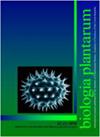蓝桉逆境响应基因dnn -10的分子特征及表达研究
IF 0.9
4区 生物学
Q4 PLANT SCIENCES
引用次数: 0
摘要
干旱、盐度和霜冻导致植物细胞脱水。植物中的脱水信号触发脱水诱导的细胞蛋白(dehydrins)的合成,Yao等人(2005)和Ali等人(2014,2016)于1989年首次在玉米和大麦中观察到这一现象。脱水蛋白属于一个多蛋白家族,称为晚期胚胎发生丰富蛋白(LEA)蛋白群-2 (Puhakainen et al. 2004, Yang et al. 2012)。脱水剂位于细胞质、细胞核、线粒体和叶绿体中(Xu et al. 2005)。此外,在内质网、质膜和细胞体中也发现了脱水剂(Close et al. 1993, Close 1996)。与其他LEA蛋白一样,在发育后期的植物胚胎中,已经观察到脱水蛋白的大量积累(Hanin et al. 2011)。当植物受到渗透胁迫、干旱、盐度和高温等可能导致细胞脱水的环境胁迫时,脱水剂在所有营养组织中广泛积累(Hanin et al. 2011)。脱水剂具有亲水性和耐热性本文章由计算机程序翻译,如有差异,请以英文原文为准。
Molecular characterization and expression studiesof Eucalyptus globulus stress-responsive gene DHN-10
Drought, salinity, and frost result in dehydration of plant cells. The dehydration signals in plants trigger the synthesis of dehydration-induced cellular proteins (dehydrins) which were first observed in maize and barley in 1989 as reported in Yao et al. (2005) and Ali et al. (2014, 2016). Dehydrins belong to a multi-protein family called late embryogenesis abundant (LEA) proteins group-2 (Puhakainen et al. 2004, Yang et al. 2012). The dehydrins are located in the cytoplasm, nucleus, mitochondria, and chloroplast (Xu et al. 2005). Further, dehydrins have been found in the endoplasmic reticulum, plasma membrane, and tonoplasts (Close et al. 1993, Close 1996). The extensive accumulation of dehydrins has been observed in the plant embryos during later developmental stages, just like other LEA proteins (Hanin et al. 2011). The dehydrins accumulate extensively in all vegetative tissues when plants are subjected to environmental stresses that may cause the dehydration of cells like osmotic stress, drought, salinity, and heat (Hanin et al. 2011). The dehydrins are hydrophilic and thermostable
求助全文
通过发布文献求助,成功后即可免费获取论文全文。
去求助
来源期刊

Biologia Plantarum
生物-植物科学
CiteScore
2.80
自引率
0.00%
发文量
28
审稿时长
3.3 months
期刊介绍:
BIOLOGIA PLANTARUM is an international journal for experimental botany. It publishes original scientific papers and brief communications, reviews on specialized topics, and book reviews in plant physiology, plant biochemistry and biophysics, physiological anatomy, ecophysiology, genetics, molecular biology, cell biology, evolution, and pathophysiology. All papers should contribute substantially to the current level of plant science and combine originality with a potential general interest. The journal focuses on model and crop plants, as well as on under-investigated species.
 求助内容:
求助内容: 应助结果提醒方式:
应助结果提醒方式:


